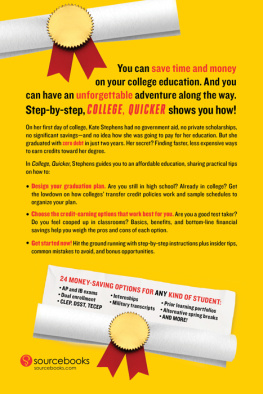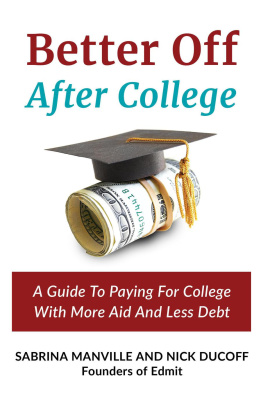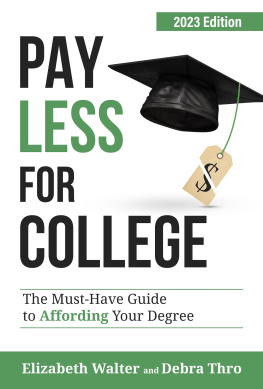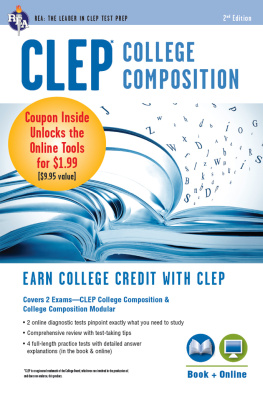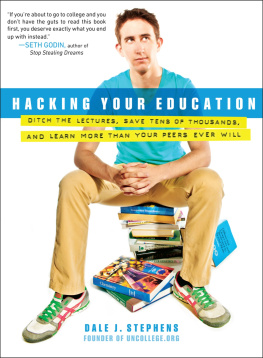Copyright 2015 by Kate Stephens
Cover and internal design 2015 by Sourcebooks, Inc.
Cover design by The Book Designers
Cover images Mega Pixel/Shutterstock, koosen/Shutterstock
Sourcebooks and the colophon are registered trademarks of Sourcebooks, Inc.
All rights reserved. No part of this book may be reproduced in any form or by any electronic or mechanical means including information storage and retrieval systemsexcept in the case of brief quotations embodied in critical articles or reviewswithout permission in writing from its publisher, Sourcebooks, Inc.
This publication is designed to provide accurate and authoritative information in regard to the subject matter covered. It is sold with the understanding that the publisher is not engaged in rendering legal, accounting, or other professional service. If legal advice or other expert assistance is required, the services of a competent professional person should be sought. From a Declaration of Principles Jointly Adopted by a Committee of the American Bar Association and a Committee of Publishers and Associations
All brand names and product names used in this book are trademarks, registered trademarks, or trade names of their respective holders. Sourcebooks, Inc., is not associated with any product or vendor in this book.
Published by Sourcebooks, Inc.
P.O. Box 4410, Naperville, Illinois 60567-4410
(630) 961-3900
Fax: (630) 961-2168
www.sourcebooks.com
Library of Congress Cataloging-in-Publication data is on file with the publisher.
Theres a popular saying that behind every great man is a great woman. In my case, the opposite is true and has one very important addition. Behind this woman is not only a great man, but an even greater God.
I dedicate this book to them both.
CONTENTS
INTRODUCTION
LIFE. During childhood, I played this game incessantly. I delighted in the virtually endless combinations. I could work as a doctor, a lawyer, or an accountant; live in a mansion, log cabin, or Tudor style; and drive a purple, yellow, or green car. But while I often chose different occupations, residences, and automobiles, I almost always selected the college before career path. Even as young as five, I understood the value of a bachelors degree. Youd have more career options and could earn more money. So without much thought, I asked the banker for $100k in loan slips to cover my education costs. Even with the interest, I would accumulate enough to settle my debt after a couple PAY DAYs.
Although this decision was easy in the game, it was much harder in the real world. As I grew older, I discovered the truth about the price of college. It didnt cost one or two PAY DAYs; it cost 10 years of barely scraping by. Not wanting this life, I decided to create my own path. I would still graduate with a college diploma but without student loans. Obviously, this was easier said than done. I didnt have an Education Savings Account, a 529 Plan, or a trust fund. Just a few hundred dollars at a local bank. Nearly broke, I would need to roll up my sleeves and bring in the money myself.
I first tried the government aid route. While I didnt live on skid row, I didnt reside on Park Avenue either. I came from a middle-class family. And due to our income bracket, I expected some state or federal grants. To attain this money, I filed the FAFSA and patiently waited for my official financial aid award letters. In the spring, they arrived from the colleges Id been accepted to. Most of the schools awarded me a small amount of scholarship money, but Uncle Sam offered me only loans. The land of the free didnt give me a penny free. Yet even though the state and federal financial aid systems had failed me, I wasnt ready to quit. I had a couple other moneymaking options. One down, two to go.
Next, I tried the private scholarships route. Like thousands of other high school students, I searched Fastweb for scholarships offered by organizations other than colleges. Unfortunately, I wasnt eligible for many. But the few I did qualify for, I applied to over the next several weeks. I spent hours on the computer; I wrote essay after essay after essay. Yet my valiant effort was all for naught. I didnt win one. Thats right, not even one. And with schoolwork continuing to mount, I decided to move on to the most reliable moneymaking venture. Two down, only one to go.
For my last attempt, I tried the job route. Although I started babysitting at age 12, I never worked more than a few hours a week. And $50 wouldnt pay for a textbook, let alone tuition. I needed steady employment. Since an espresso shop exists on literally every corner in Seattle, I applied for a barista position. Within a month, I was manning the cash register and the coffeemaker. But between serving and studying, I had little free time. And with my minimum-wage paycheck, I couldnt tuck much away. By the time I gave my two-weeks notice, I had stashed only around $2,000 in savings. A far cry from the $120K college sticker price. Three down, none left.
At this point, I wanted to throw in the towel, wave the white flag. Maybe my goal wasnt achievable. Just when I was ready to surrender, I remembered a line from a late-night infomercial. Theres got to be a better way. Clich as it might sound, the TV host was right. I had tried the traditional routes: government aid, private scholarships, and part-time work. And they left me tired and tapped out. I needed an alternative. I racked my brain but came up with nothing. What was this better way?
Unbeknownst to me, the answer sat right under my nose. During high school, I participated in a summer scholars program and a dual enrollment program. I desired college academics as well as college experiences. In addition to fulfilling both of these wants, the programs also helped me earn almost a semester of college credit. But since I was too focused on winning essay scholarships and working extra shifts my senior year, I forgot about this perk. However, I was quickly reminded during a visit to the registrars office at my university. After looking over my college transcripts from the high school programs, the transcript analyst made an astute observation. Because of my previously earned credit, I could possibly graduate early.
It was my aha! moment. I had at last discovered the better way. And it had nothing to do with making more money. It dealt with the root of the problem: time. Instead of attending my university for four years, I would go for only two years and complete the remaining 60 credits elsewhere. That meant having to pay just two years worth of high tuition, room, and board costs, instead of four. But once again, a question lingered in my mind. How would I obtain these credits?
Compared to the first one, this question didnt have a single answer. I could earn credits through many different kinds of courses, exams, and activities. But as there was no universal list or comprehensive resource explaining all of these opportunities, Id have to find them myself. I sought out suggestions from counselors, teachers, peers, and online forums. And if an idea seemed plausible and affordable, I gave it a go. Fortunately, my hard work paid off. At age 20, I graduated summa cum laude with a bachelors degree. But my 4.0 GPA wasnt even the best part. Because college ended up costing nearly half my original estimate, I had just enough funds from university scholarships and part-time work to cover it and walk away with my diploma debt-free.

